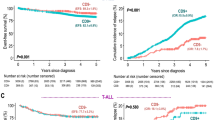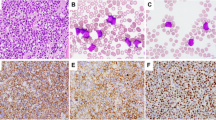Abstract
The t(12;21)(p13;q22) is the most common translocation in childhood B-precursor ALL. It results in a TEL-AML1 rearrangement and is associated with a good prognosis. Because many chromosomal alterations in leukemia are associated with distinct cell surface phenotypes, we investigated whether there was an association seen between surface marker expression and the TEL-AML1 rearrangement. Of 166 unselected cases of B-precursor ALL studied by Southern hybridization, 45 cases (27%) showed TEL rearrangement. Blasts of patients with TEL rearrangement were much more likely to be CD9-negative, CD45-positive, CD13 positive, and CD20 negative, but the predictive value of any of these markers for the rearrangement was very low. However, 93% of patients with the TEL rearrangement had blasts that were either negative or only partly positive for CD9; this phenotype was only seen in 27% of patients without the rearrangement. Only information about CD20 expression added to the predictive value of CD9 alone. The predictive value of the phenotype CD9 (negative or partly positive) and CD20 (negative or partly positive), for the TEL rearrangement was prospectively tested on an additional 223 cases, and found to be 88% sensitive and 71% specific for the rearrangement, with a positive predictive value of 47%. Hyperdiploidy, previously shown to correlate negatively with the rearrangement, was a slightly more sensitive indicator (94%) but had a much lower predictive value (28%). Three of eight cases found to be rearranged by Southern hybridization but lacking the characteristic phenotype failed to show evidence of the TEL-AML1 rearrangement by polymerase chain reaction, suggesting that at least some of the discordant cases may involve partner genes other than AML1 in the TEL rearrangement. We conclude that immunophenotyping is highly predictive of the TEL rearrangement. For every 100 patients with B-precursor ALL, we estimate that prescreening by phenotyping would eliminate the need for molecular testing on 57 patients and only two or three of an expected 24 patients with the TEL rearrangement would not be detected.
This is a preview of subscription content, access via your institution
Access options
Subscribe to this journal
Receive 12 print issues and online access
$259.00 per year
only $21.58 per issue
Buy this article
- Purchase on Springer Link
- Instant access to full article PDF
Prices may be subject to local taxes which are calculated during checkout
Similar content being viewed by others
Author information
Authors and Affiliations
Rights and permissions
About this article
Cite this article
Borowitz, M., Rubnitz, J., Nash, M. et al. Surface antigen phenotype can predict TEL-AML1 rearrangement in childhood B-precursor ALL: a Pediatric Oncology Group study. Leukemia 12, 1764–1770 (1998). https://doi.org/10.1038/sj.leu.2401177
Received:
Accepted:
Published:
Issue Date:
DOI: https://doi.org/10.1038/sj.leu.2401177
Keywords
This article is cited by
-
Flow cytometry in the diagnosis and monitoring of acute leukemia in children
Journal of Hematopathology (2015)
-
EuroFlow antibody panels for standardized n-dimensional flow cytometric immunophenotyping of normal, reactive and malignant leukocytes
Leukemia (2012)
-
Acute myeloid leukemia with MLL rearrangements: clinicobiological features, prognostic impact and value of flow cytometry in the detection of residual leukemic cells
Leukemia (2003)



